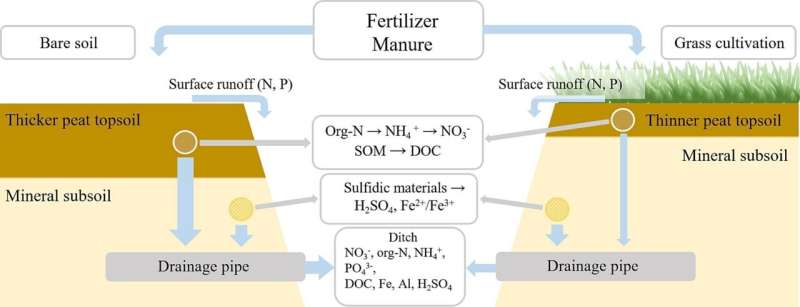This article has been reviewed according to Science X's editorial process and policies. Editors have highlighted the following attributes while ensuring the content's credibility:
fact-checked
peer-reviewed publication
proofread
Cultivation of grass significantly reduces nitrogen leaching from cultivated peatlands: Study

Perennial grass cover significantly reduces nitrogen leaching from cultivated peatlands, according to a recent study published in Science of The Total Environment. In measurements of Ruukki NorPeat field, the least amount of nitrogen was leached from field blocks covered with grass and thin peat layer. The largest nitrogen leaching came from plots with thicker peat without plant cover or with barley in the spring and during the mild winter. Phosphorus and organic carbon leaching increased as peat thickness increased.
In the study by the Natural Resources Institute Finland (Luke) and the University of Oulu, the concentrations of soil nutrients (nitrogen, phosphorus, organic carbon) and other substances harmful to water bodies (sulfur, iron, aluminum and acidity) were measured year-round from the runoff of cultivated peatland for three years (2018–2021). The amount of nutrients and substances released from the field was examined in relation to the season, soil properties and field cultivation activities in order to identify the most important factors affecting leaching.
The study found that when barley was grown on the field or the field was left bare for the winter, the leaching of nitrogen from the field was high, especially from the field blocks where the peat layer was thicker (more than 75 cm). Perennial grass cover, on the other hand, led to a significant decrease in nitrogen leaching and a decrease in phosphorus leaching.
"Phosphorus leaching on Ruukki's NorPeat field is low compared to cultivated soils in Finland. However, the study found that especially as the thickness of the peat increased, the leaching of both phosphorus and organic carbon increased," says researcher Maarit Liimatainen from Luke.
Vegetation cover of cultivated peatlands is important also during winter
About 10% of Finland's arable land is cultivated peatlands, but in Northern Ostrobothnia and Northern Finland the proportion is up to 30% in some places. In most of these, grass fodder is grown for milk and beef production.
"The research results show the importance of grass cover, especially in reducing the nitrogen leaching from cultivated peatlands. Nitrogen leaching from grass cover are also lower in winter, which is important if the winters become milder," says Liimatainen.
In the future, she emphasizes the importance of finding out the overall picture of the environmental effects of cultivated peatlands.
"In the new experimental set-up of the NorPeat research field, the aim is to control the groundwater level with the help of controlled sub-irrigation and the extra water provided by the water storage reservoir. The aim of water management is to mitigate greenhouse gas emissions and at the same time to study the leaching effects on recipient waters," says Liimatainen.
More information: Tung Pham et al, Leaching of nitrogen, phosphorus and other solutes from a controlled drainage cultivated peatland in Ruukki, Finland, Science of The Total Environment (2023). DOI: 10.1016/j.scitotenv.2023.166769
Journal information: Science of the Total Environment
Provided by Natural Resources Institute Finland (Luke)




















